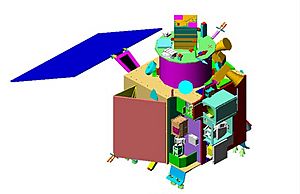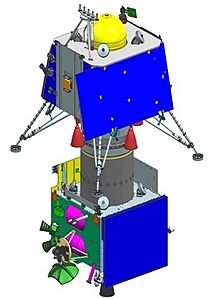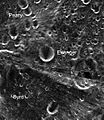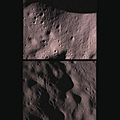Chandrayaan programme facts for kids
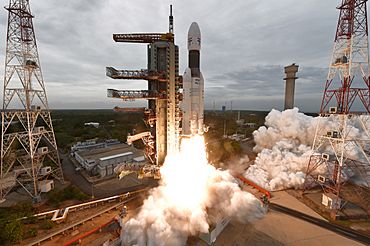
LVM3 M1 lifting off with Chandrayaan-2 on 22 July 2019
|
|
| Country | India |
|---|---|
| Organization | ISRO |
| Purpose | Exploration of the Moon |
| Status | Active |
| Program history | |
| Cost | ₹1,364 crore (US$230 million) |
| Duration | 2008–present |
| First flight | Chandrayaan-1, 22 October 2008 |
| Last flight | Chandrayaan-3, 14 July 2023 |
| Launch site(s) | Satish Dhawan Space Centre |
| Vehicle information | |
| Launch vehicle(s) |
|
The Chandrayaan programme (romanized: Candrayāna, ) also known as the Indian Lunar Exploration Program is an ongoing series of outer space missions by the Indian Space Research Organization (ISRO) for the exploration of the Moon. The program incorporates a lunar orbiter, an impactor, a soft lander and a rover spacecraft.
There have been three missions so far with a total of two orbiters, landers and rovers each. While the two orbiters were successful, the first lander and rover which were part of the Chandrayaan-2 mission, crashed on the surface. The current Chandrayaan-3 successfully landed on the moon on 23 August 2023, making India the first nation to successfully land a spacecraft on the lunar south pole region, and only the fourth country ever to land on the moon.
Contents
Programme structure
The Chandrayaan (Indian Lunar Exploration Programme) programme is a multiple mission programme. As of September 2019[update], one orbiter with an impactor probe has been sent to the Moon, using ISRO's workhorse PSLV rocket. The second spacecraft consisting of orbiter, soft lander and rover was launched on 22 July 2019, by using a LVM3 rocket. In a podcast from AT, VSSC director S. Somanath stated that there will be a Chandrayaan-3 and more follow up missions in Chandrayaan Program. The Chandrayaan-3 mission was launched in 14 July 2023 using LVM-3 and it is expected to reach Moon's surface in August.
Phase I: Orbiter and Impactor
Prime Minister Atal Bihari Vajpayee announced the Chandrayaan project on course in his Independence Day speech on 15 August 2003. The mission was a major boost to India's space program. The idea of an Indian scientific mission to the Moon was first mooted in 1999 during a meeting of the Indian Academy of Sciences. The Astronautical Society of India carried forward the idea in 2000. Soon after, the Indian Space Research Organisation (ISRO) set up the National Lunar Mission Task Force which concluded that ISRO has the technical expertise to carry out an Indian mission to the Moon. In April 2003 over 100 eminent Indian scientists in the fields of planetary and space sciences, Earth sciences, physics, chemistry, astronomy, astrophysics and engineering and communication sciences discussed and approved the Task Force recommendation to launch an Indian probe to the Moon. Six months later, in November, the Indian government gave the nod for the mission.
The first phase includes the launch of the first lunar orbiters.
- Chandrayaan-1, launched on 22 October 2008 aboard a PSLV-XL rocket, was a big success for ISRO as the Moon Impact Probe, a payload on board the Chandrayaan-1 spacecraft, discovered water on the Moon. Apart from detecting water the Chandrayaan-1 mission performed several other tasks such as mapping and atmospheric profiling of the Moon.
Phase II: Soft landers and rovers
On 18 September 2008, the First Manmohan Singh Cabinet approved the mission. Although ISRO finalised the payload for Chandrayaan-2 per schedule, the mission was postponed in January 2013 and rescheduled to 2016 because Russia was unable to develop the lander on time. Roscosmos later withdrew in wake of the failure of the Fobos-Grunt mission to Mars, since the technical aspects connected with the Fobos-Grunt mission were also used in the lunar projects, which needed to be reviewed. When Russia cited its inability to provide the lander even by 2015, India decided to develop the lunar mission independently and unused orbiter hardware was repurposed to be used for Mars Orbiter Mission.
Chandrayaan-2 was launched on 22 July 2019 aboard a LVM3 rocket. The spacecraft was successfully put into lunar orbit on August 20, 2019 but the lander was lost while attempting to land on 6 September 2019. The orbiter is operational, collecting scientific data, and is expected to function for 7.5 years.
In November 2019, ISRO officials stated that a new lunar lander mission was being studied for launch in November 2020. This new proposal is called Chandrayaan-3 and it would be a re-attempt to demonstrate the landing capabilities needed for the Lunar Polar Exploration Mission proposed in partnership with Japan for 2025. This spacecraft configuration would not include launching an orbiter and would have a lander, rover, and a propulsion module with mission costing ₹ 250 crore with additional launch costs of ₹ 365 crore for LVM3. This third mission would land in the same area as the second one. Chandrayaan-3 was launched on 14 July 2023 at 9:05:17 UTC. The primary goals of the Chandrayaan-3 mission encompass three key aspects. Firstly, it aims to showcase a successful and controlled touchdown on the lunar surface. Secondly, it intends to demonstrate the mobility of a rover on the Moon's terrain. Lastly, it seeks to carry out scientific experiments directly on the lunar surface.
The lander and rover of Chandrayaan-3 landed near the lunar south pole region on 23 August 2023.
Phase III: On site sampling
- Lunar Polar Exploration Mission
The next mission will be the Lunar Polar Exploration Mission or Chandrayaan-4, suggested to be launched in a time frame of 2026-28. India is collaborating with Japan in this mission but the mission is not yet defined. It will be a lander-rover mission near lunar pole to perform on site sampling and analysis of collected lunar material and demonstrate lunar night survival technologies.
List of missions
- Landing
Successful hard landing
Successful soft landing
Unsuccessful landing
- Mission
Successful and inactive
Active
Unsuccessful
| Mission |
Launch Date |
Launch Vehicle |
Orbital Insertion Date | Landing Date | Return Date | Status | ||||
|---|---|---|---|---|---|---|---|---|---|---|
| Main Mission |
Extended Mission |
Expected Mission Duration | Total Mission Duration | Notes | ||||||
| Phase 1: Orbiter and impactor | ||||||||||
| Chandrayaan-1 | 22 October 2008 | PSLV-XL | 8 November 2008 | 14 November 2008 | – | Success | – | 2 years | 310 days | First Indian Lunar mission; discovered water on the Moon. |
| Phase 2: Soft landers and rovers | ||||||||||
| Chandrayaan-2 | 22 July 2019 | LVM3 | 20 August 2019 | 6 September 2019 | – | Success | Ongoing | 7.5 years | 5 years, 7 months, 13 days elapsed | First Indian Lunar lander and rover mission; lander crashed. |
| Chandrayaan-3 | 14 July 2023 | 5 August 2023 | 23 August 2023 | – | Ongoing | TBD | 14 days | 1 year, 7 months, 23 days elapsed | First Indian lunar soft landing; humanity's first landing near lunar south pole. | |
| Phase 3: Onsite sampling | ||||||||||
| LUPEX | TBD 2026-28 | H3 | TBD | TBD | – | TBD | TBD | 6 months | TBD | Collaborative mission with JAXA. |
Gallery
-
Images taken by Moon Impact Probe before performing a hard landing near the outer rim of Shackleton crater in the Lunar south pole region.
-
Second confirmation of water on Moon by Chandrayaan-1's Moon Mineralogy Mapper, three months after the discovery by Moon Impact Probe.
-
Far side of the Moon as viewed by Chandrayaan-2's LI4 (Lander Imager 4) Camera, 21 August 2019.
See also
- List of missions to the Moon
- Indian Mars exploration missions
- Indian Human Spaceflight Programme


